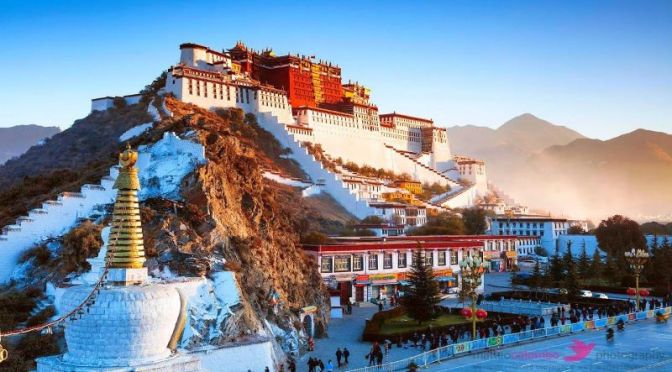Potala Palace, Tibet – A Masterpiece of Tibetan Art and Architecture, at 12,139 Feet Above Sea Level, Potala is the Highest Palace in the World. The 1,300-year-old Structure Was Originally Built as a Gesture of Love, Commissioned by Tibetan King Songtsen Gambo for His Marriage to Princess Wencheng of the Chinese Tang Dynasty. Eventually Monks Came to Rule Tibet and the Palace Was Expanded and Converted Into the Winter Residence for the Dalai Lama.
Angkor Wat, Cambodia – Angkor Wat is a Hindu Temple Complex in Cambodia and is the Largest Religious Monument in the World, on a Site Measuring 162.6 Hectares. Originally Constructed as a Hindu Temple Dedicated to the God Vishnu for the Khmer Empire, It Was Gradually Transformed Into a Buddhist Temple Towards the End of the 12th Century, Angkor Wat is the Prime Example of the Classical Style of Khmer Architecture, the Temple Attains a Classic Perfection by the Restrained Monumentality of Its Finely Balanced Elements and the Precise Arrangement of Its Proportions.
St. Peter’s Basilica, Vatican City – The Most Famous Roman Catholic Church in the World. Dating Back to Roman Architecture of the Early Christian Art Period. The Basilica, Was Built Above the Burial Site of St. Peter, One of the Twelve Disciples of Jesus and the First Bishop of Rome Construction Began in 1506 and It Took 120 Years Before the Church Could Be Consecrated. To This Day Saint Peter’s Remains One of the Largest Churches in the World.
Taktsang Monastery (Tiger Nest), Bhutan – Paro Taktsang Monastery is One of the Most Important Symbols of Culture and Religion in the Kingdom of Bhutan, Located High in the Himalaya Mountains. Like Many Prominent Buildings in Bhutan, Paro Taktsang Features Stark White Exterior Walls and Red Shingled Roofs as Well as Golden Roofs. Temples in Bhutan Are Typically Constructed of Stone and Rammed Mud. The Interior of Paro Taktsang Features Golden Ceilings, Golden Idols and the Hall of a Thousand Buddhas, Where a Statue of a Large Tiger Can Be Found.
Bagan, Myanmar – Also Known as the Land of a Thousand Temples, the Ancient Kingdom of Bagan in Myanmar is Symbol of Burmese Religion, History and Culture, Once a Major Power in Southeast Asia, Bagan is Home to Over Two Thousand Buddhist Temples Standing as Symbols of Burmese History and Culture, Bagan Temples Are Unique Among Southeast Asian Architectural Styles. They Are Characterized by Central, Square Structures Built Around Shrines, With Interior Passages Supported by Vaulted Arches Radiating Outward.
Borobudur, Indonesia – This 9th Century Buddhist Construction in Central Java is Indonesia’s Greatest Tourist Attraction, the Temple Design Follows Javanese Buddhist Architecture, Which Blends the Indonesian Indigenous Cult of Ancestor Worship and the Buddhist Concept of Attaining Nirvana. The Temple Demonstrates the Influences of Gupta Art That Reflects India’s Influence on the Region, Yet There Are Enough Indigenous Scenes and Elements Incorporated to Make Borobudur Uniquely Indonesian.
Karnak, Egypt – Karnak is the Largest Ancient Religious Site in the World, a Complex Made Up of Three Main Temples. One of Its Most Famous Features is the Hypostyle Hall, Which Has 134 Massive Columns That Rise Up to 60 Feet in Height, and Ten Feet Across. Karnak Was Not a Quick Build. It Took Fifteen Hundred Years to Complete.

